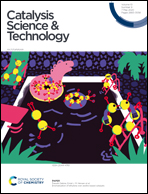Ultraviolet-induced Ostwald ripening strategy towards a mesoporous Ga2O3/GaOOH heterojunction composite with a controllable structure for enhanced photocatalytic hydrogen evolution†
Abstract
The design of efficient semiconductor oxide materials with heterojunction nanostructures for photocatalysis holds great promise in the fields of clean energy conversion and storage. Current synthesis methods for heterojunction composites readily result in phase separation and uncontrollable products, and require harsh preparation methods. In order to address these issues and optimize the microstructure of the heterojunction photocatalyst, controllable synthesis and differences in the porosity are introduced. For the first time, we synthesized a mesoporous Ga2O3/GaOOH heterojunction composite for photocatalytic hydrogen generation using an ingenious ultraviolet-induced Ostwald ripening strategy. Furthermore, the detailed formation mechanism and energy band structure of the as-synthesized material were elucidated. The intimate contact of the heterojunction, refined mesoporous structure and large specific surface area of the mesoporous Ga2O3/GaOOH heterojunction composite endow the material with efficient charge separation and transfer and significantly exposed junction active sites, which results in an enhanced photocatalytic hydrogen generation performance. This study opens up new horizons in the construction of mesoporous metal oxide heterojunction composites.



 Please wait while we load your content...
Please wait while we load your content...